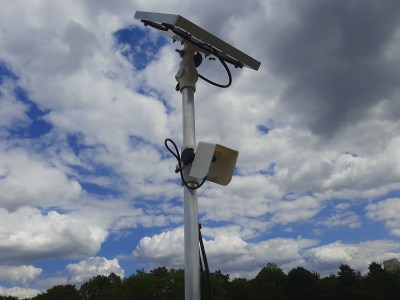If you live anywhere on the Northern Hemisphere, you’re likely to have experienced one of the many heatwaves that occurred this summer. Extreme heat is dangerous for humans and animals, but plants, including important crops, also suffer. High temperatures lead to increased transpiration and evaporation, and if the water lost in this way is not replenished quickly enough, plants will stop growing and eventually wither and die.
In order to keep track of the amount of water available to crops, [Florian Ellsäßer] built the Crop Water Stress Sensor: a device that checks whether plants have enough moisture available to stay healthy. It does this by measuring the temperature of the leaves to calculate evaporation levels. If the leaves are cooler than their surroundings, this means that water is evaporating from them and the plant apparently has enough water available. If the leaves’ temperature is closer to the ambient temperature, then the plant may be running low on water.
 [Florian]’s system performs this measurement using an infrared array, which is basically a low-resolution thermal camera that remotely measures the temperature of everything in its field of view. This IR array is pointed at a field, where it will see both leaves and the ground between them. The difference in temperature between these two can then be used to calculate the Crop Water Stress Index (CWSI), a standardized measure of how well-hydrated plants are. The result is shown on a display and also indicated using a convenient red-yellow-green status LED that shows if the crops in question need watering.
[Florian]’s system performs this measurement using an infrared array, which is basically a low-resolution thermal camera that remotely measures the temperature of everything in its field of view. This IR array is pointed at a field, where it will see both leaves and the ground between them. The difference in temperature between these two can then be used to calculate the Crop Water Stress Index (CWSI), a standardized measure of how well-hydrated plants are. The result is shown on a display and also indicated using a convenient red-yellow-green status LED that shows if the crops in question need watering.
The system can be solar powered for completely remote operation, while its data can be read out through a WiFi interface. [Florian] is planning to update the design with a LoRa interface for greater range: the eventual goal is to build a large network of these sensors throughout agricultural areas and use the combined data to raise awareness of water shortages in certain areas. In order to make the sensors easy to build by anyone interested, all design files are available on the project page.
Keeping crops moisturized is one of the key tasks of agriculture, and we’ve seen several projects that aim to optimize and automate it, from a simple-but-effective ESP8266-based moisture sensor to complete hydroponics systems.













